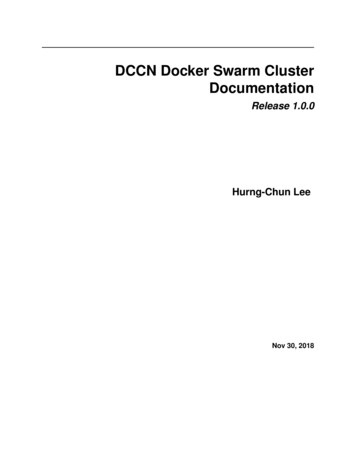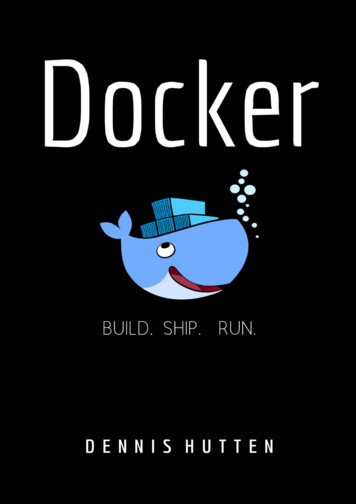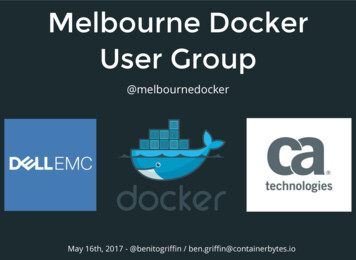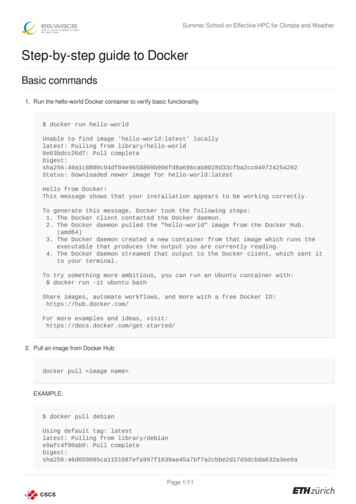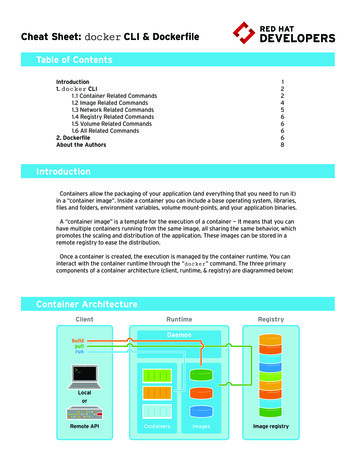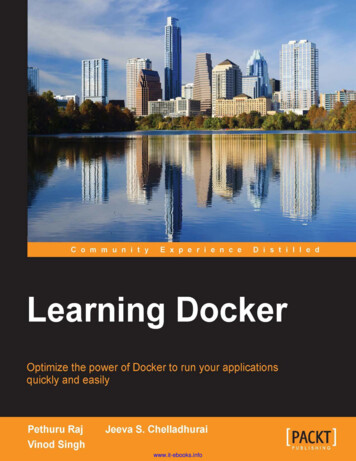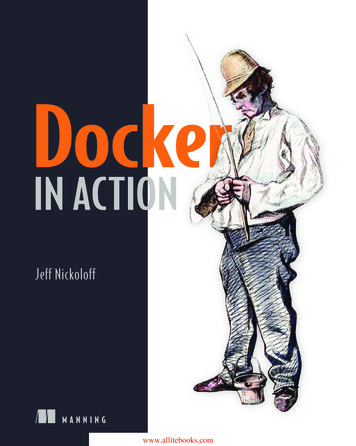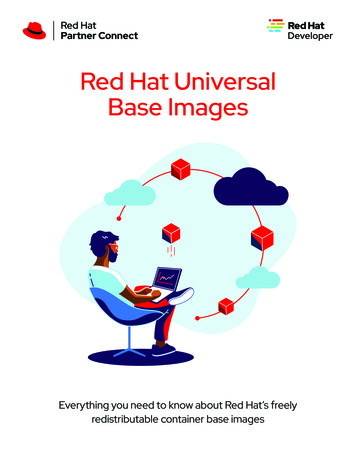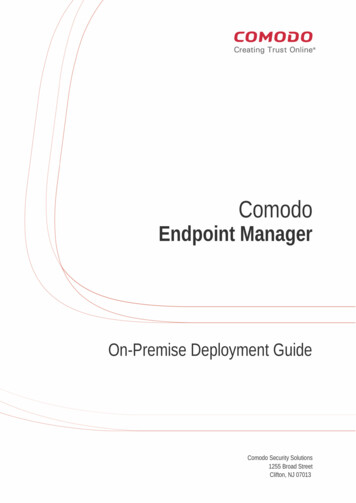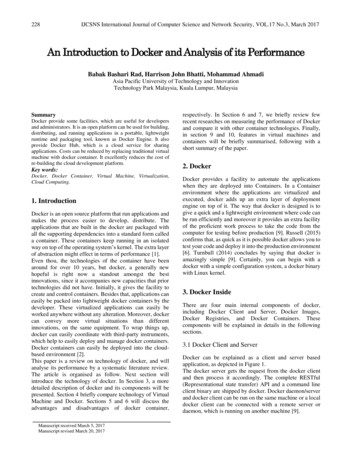
Transcription
IJCSNS International Journal of Computer Science and Network Security, VOL.17 No.3, March 2017228An Introduction to Docker and Analysis of its PerformanceBabak Bashari Rad, Harrison John Bhatti, Mohammad AhmadiAsia Pacific University of Technology and InnovationTechnology Park Malaysia, Kuala Lumpur, MalaysiaSummaryDocker provide some facilities, which are useful for developersand administrators. It is an open platform can be used for building,distributing, and running applications in a portable, lightweightruntime and packaging tool, known as Docker Engine. It alsoprovide Docker Hub, which is a cloud service for sharingapplications. Costs can be reduced by replacing traditional virtualmachine with docker container. It excellently reduces the cost ofre-building the cloud development platform.Key words:Docker, Docker Container, Virtual Machine, Virtualization,Cloud Computing.1. IntroductionDocker is an open source platform that run applications andmakes the process easier to develop, distribute. Theapplications that are built in the docker are packaged withall the supporting dependencies into a standard form calleda container. These containers keep running in an isolatedway on top of the operating system’s kernel. The extra layerof abstraction might effect in terms of performance [1].Even thou, the technologies of the container have beenaround for over 10 years, but docker, a generally newhopeful is right now a standout amongst the bestinnovations, since it accompanies new capacities that priortechnologies did not have. Initially, it gives the facility tocreate and control containers. Besides that, applications caneasily be packed into lightweight docker containers by thedeveloper. These virtualized applications can easily beworked anywhere without any alteration. Moreover, dockercan convey more virtual situations than differentinnovations, on the same equipment. To wrap things up,docker can easily coordinate with third-party instruments,which help to easily deploy and manage docker containers.Docker containers can easily be deployed into the cloudbased environment [2].This paper is a review on technology of docker, and willanalyse its performance by a systematic literature review.The article is organised as follow. Next section willintroduce the technology of docker. In Section 3, a moredetailed description of docker and its components will bepresented. Section 4 briefly compare technology of VirtualMachine and Docker. Sections 5 and 6 will discuss theadvantages and disadvantages of docker container,Manuscript received March 5, 2017Manuscript revised March 20, 2017respectively. In Section 6 and 7, we briefly review fewrecent researches on measuring the performance of Dockerand compare it with other container technologies. Finally,in section 9 and 10, features in virtual machines andcontainers will be briefly summarised, following with ashort summary of the paper.2. DockerDocker provides a facility to automate the applicationswhen they are deployed into Containers. In a Containerenvironment where the applications are virtualized andexecuted, docker adds up an extra layer of deploymentengine on top of it. The way that docker is designed is togive a quick and a lightweight environment where code canbe run efficiently and moreover it provides an extra facilityof the proficient work process to take the code from thecomputer for testing before production [9]. Russell (2015)confirms that, as quick as it is possible docker allows you totest your code and deploy it into the production environment[6]. Turnbull (2014) concludes by saying that docker isamazingly simple [9]. Certainly, you can begin with adocker with a simple configuration system, a docker binarywith Linux kernel.3. Docker InsideThere are four main internal components of docker,including Docker Client and Server, Docker Images,Docker Registries, and Docker Containers. Thesecomponents will be explained in details in the followingsections.3.1 Docker Client and ServerDocker can be explained as a client and server basedapplication, as depicted in Figure 1.The docker server gets the request from the docker clientand then process it accordingly. The complete RESTful(Representational state transfer) API and a command lineclient binary are shipped by docker. Docker daemon/serverand docker client can be run on the same machine or a localdocker client can be connected with a remote server ordaemon, which is running on another machine [9].
IJCSNS International Journal of Computer Science and Network Security, VOL.17 No.3, March 20172293.4 Docker ContainersDocker image creates a docker container. Containers holdthe whole kit required for an application, so the applicationcan be run in an isolated way. For example, suppose thereis an image of Ubuntu OS with SQL SERVER, when thisimage is run with docker run command, then a containerwill be created and SQL SERVER will be running onUbuntu OS.4. Virtual Machine vs. DockerVirtualization is an old concept, which has been in used incloud computing, after IaaS has been accepted as a crucialtechnique for system constitution, resource provisioning,and multi-tenancy. Virtualized resources play the main rolein solving the problems using the core technique of cloudcomputing. The Figure 2 shows the architecture of thevirtual machine.Fig. 1 Docker architecture [9].3.2 Docker ImagesThere are two methods to build an image. The first one is tobuild an image by using a read-only template. Thefoundation of every image is a base image. Operatingsystem images are basically the base images, such asUbuntu 14.04 LTS, or Fedora 20. The images of operatingsystem create a container with an ability of completerunning OS. Base image can also be created from thescratch. Required applications can be added to the baseimage by modifying it, but it is necessary to build a newimage. The process of building a new image is called“committing a change”. The second method is to create adocker file. The docker file contains a list of instructionswhen “Docker build” command is run from the bashterminal it follows all the instructions given in the dockerfile and builds an image. This is an automated way ofbuilding an image.3.3 Docker RegistriesDocker images are placed in docker registries. It workscorrespondingly to source code repositories where imagescan be pushed or pulled from a single source. There are twotypes of registries, public and private. Docker Hub is calleda public registry where everyone can pull available imagesand push their own images without creating an image fromthe scratch. Images can be distributed to a particular area(public or private) by using docker hub feature.Fig. 2 Virtual Machine architecture [11].Hypervisor is lying between host and guest operatingsystems. It is a virtual platform and it handles more than oneoperating system in the server. It works between theoperating system and CPU. The virtualization divides it intotwo segments: the first one is Para-Virtualization and thesecond one is Full Virtualization [3]. Figure 3 depicts thearchitecture of the Docker Container.Linux containers are managed by the docker tool and it isused as a method of operating system level virtualization.Figure 3 shows that in single control host there are manyLinux containers, which are isolated. Resources such asNetwork, Memory, CPU, and Block I/O are allocated byLinux kernel and it also deals with cgroups without startingvirtualization machine [8].
230IJCSNS International Journal of Computer Science and Network Security, VOL.17 No.3, March 2017technology and they need to run on a different operatingsystem.5. Advantages of Docker ContainerThe demand and the advancement of Linux containerscan be seen in the last few years. Docker has becomepopular very quickly, because of the benefits providedby docker container. The main advantages of dockerare speed, portability, scalability, rapid delivery, anddensity.5.1 SpeedFig. 3 Docker Container architecture [11].According to Waldspurger (2002), in the Linux containers,an architecture is to manage CPU and distribute itsresources more proficiently. In any example of Hyper-V orVMWare, because of overhead incurred, it is not easy to runmore than ten virtual machines [13]. Up to a great extent,this issue has been solved by the containers. Containers onlyutilize those resources, which are needed for the services orapplications. Therefore, on a weak configured machine,above 50 requests of the containers can be executed.For example, suppose an organisation provides emailsecurity services. The major functions of these services areto check emails for viruses, spam, and malware. Moreover,it could manage to transfer messages to the agent, logs andreport delivery failure if the product is installed in the cloud[10]. Mostly in these cases, there is no use of any associateddependencies or OS level libraries or any kernel datastructure. Therefore, it is worthwhile to containerized everycomponent by sandboxing them utilizing OpenVZ orDocker instead of having virtual machines.In many enterprises, virtual machines are used to performelement testing. In this process, a lot of CPU resources andmemory space are consumed. Whereas, containertechnology provides a guarantee to their users that excess ofa workload would not affect the efficiency of the resources.The container takes less time for installation as compared tovirtual machines, so the adaptability of containers is muchhigher than VMs.Furthermore, both Docker and OpenVZ have been undergreat examination in terms of their security aspects. Whenisolation is reduced, it directly affects the security, whichalso decreases rapidly. Root users of Linux can easily getaccess to containers as containers also use the same kerneland operating system. The isolation of docker is not asstrong as a virtual machine, even though docker isolates theapplication, which is running in the docker container fromits primary host. Additionally, it is possible that some of theapplications would not be able to run in a containerizedSpeed is one of the most exceedingly touted advantages ofContainers. When the benefits of using docker arehighlighted, it would be incredible not to mention about thespeed of docker in the conversation (Chavis & Architect,2015). The time required to build a container is very fastbecause they are really small. Development, testing, anddeployment can be done faster as containers are small.Containers can be pushed for testing once they have beenbuilt and then from there, on to the production environment[12].5.2 PortabilityThose applications that are built inside docker containersare extremely portable. These portable applications caneasily be moved as a single element and the performanceremains the same [12].5.3 ScalabilityDocker has the ability that it can be deployed in severalphysical servers, data servers, and cloud platforms. It canalso be run on every Linux machine. Containers can easilybe moved from a cloud environment to local host and fromthere back to cloud again at a fast pace. Adjustments caneasily be done; the scale can simply be adjusted by the useraccording to the need [5].5.4 Rapid DeliveryThe format of a Docker Containers is standardized soprogrammers do not have to stress over one another’s tasks.The responsibility of the administrator is to deploy andmaintain the server with containers, whereas theresponsibility of the programmer is to look after theapplications inside the docker container. Containers canwork in every environment as they have all the requireddependencies embedded within the applications and theyare all tested [12]. Docker provides a reliable, consistent,and improved environment, so predictable results can be
IJCSNS International Journal of Computer Science and Network Security, VOL.17 No.3, March 2017achieved when codes are moved between development, testand production systems (Chavis & Architect, 2015).5.5 DensityDocker uses the resources that are available more efficientlybecause it does not use a hypervisor. This is the reason thatmore containers can be run on a single host as compared tovirtual machines. The performance of a Docker Containersis higher because of higher density and no overhead wastageof resources [5].6. Disadvantages of Docker ContainerThere are some drawbacks of docker containers, which arelisted below [1, 4]: Complete virtualization is not provided by a dockerbecause it depends on the Linux kernel, which isprovided by the local host.Currently, docker does not run on older machines. Itonly supports 64-bit local machines.The complete virtualized environment must beprovided by the docker container for Windows andMac machines. Even though the boot2docker tool fillsthis gap, but still, it should be checked whether it makesobstructions to acceptance by users of these systems orthe integration and performance with the hostmachine’s operating system are adequate [4].It is necessary that the possibility of security issuesshould be evaluated. Building off trusting binariescould be made easier by digitally signing dockerimages, for future support.An important concern is to check if the teachingcommunity or scientific researcher will significantlythink of adopting docker.7. Docker PerformanceSeo et al. (2014) used two servers with the sameconfiguration in the cloud environment. One server wasused for docker and the other one was for an Open Stackplatform for KVM by means of a virtualization tool [8].According to him, a VM works independently. This factormake it easy to apply and manage the policy of network,security, user, and the system. However, docker does notcontain a guest operating system. Therefore, it takes verylittle time in distributing and gathering images. The boottime is also very short. These are the main advantages ofutilizing Docker Cloud as compared with VM Cloud.Scheepers (2014) compares LXC and Xen virtualizationtechnologies to benchmark some applications [7]. Heexplains that Xen would be a better choice in the sense ofequally distributing resources, performance is not231dependent on the other tasks, and it is executed on the samemachine. However, LXC is much better in the sense ofgetting most of the hardware resources or for the executionof smaller isolated processes. In private and dot clouds,LXC is a better option.Felter et al. (2014) evaluate the performance of threedifferent environments, Native, Docker, and KVM [3]. Heclarifies that containers and VMs are both matureinnovation that has profited from last 10 years ofincremental equipment and programming enhancements.According to this research, docker is equivalent to orsurpasses KVM execution for each situation they tried.Their outcomes demonstrate that both KVM and dockerpresent irrelevant overhead for CPU and memory execution.It has also been shown that the overall performance ofdocker is better than the Local Host, as the applicationswere executed and responded faster than in Local Host.Moreover, fewer hardware resources were used in dockercontainer to perform the tasks.Docker is really a future demanding technology. As usersand developers would know more about the docker and itscapabilities then they would consider replacing traditionalvirtualization with docker technology. Docker providesmany simple and useful features. To get the bestperformance and results, it is highly recommended to moveup from the default configuration. Containers provideadvanced density, better performance, scalability, andusability as compared with traditional virtualizationbecause containers smartly utilize its resources, whichreduce the chance of unnecessary overhead. Containers arebetter in performance than virtual machine, becausecontainers take less start-up time. Docker has removed thebiggest issue of “dependency”. Now containers have all oftheir required dependencies, which help containers to beproperly built, and to execute them in any dockerenvironment. An additional layer of isolation is provided bythe container, which increases the containers’ security.Docker is not as insecure as people normally think, but itprovides a complete protection.8. Docker vs. other Container TechnologyIn this section, the performance of application virtualizationand the performance of the docker container will bediscussed, and the evaluation of other containerizetechnology will be compared and reviewed. Seo et al.(2014) summarize that there is no guest OS of docker in thecloud, so the storage and the wastage of CPU resources areless [8]. The images are not disturbed; boot time is fasterand the time of generating the images is short. These are thebenefits of docker cloud in comparison with VM Cloud.They used two similar servers with the same configurationin the cloud environment. One server was used for dockerand the other one was for an Open Stack platform for KVM
232IJCSNS International Journal of Computer Science and Network Security, VOL.17 No.3, March 2017by means of a virtualization tool. Ubuntu Server was usedas a base platform [8].To calculate the approximate boot-time, 20 images weregenerated on each server and boot time was checked. Figure4 shows that the boot time of docker is lesser than the boottime of KVM. Docker uses the Host OS, whereas KVMuses Guest OS. Thus, the boot time of docker is shorter thanthe boot time of KVM.Scheepers (2014) compares LXC and Xen virtualizationtechnologies to benchmark some applications [7]. For thispurpose, Scheepers uses two servers Core OS 324.3.0 andXenServer 6.2 with docker version 0.11.1. Theconfiguration of these systems is RAM 4GB, CPU IntelXeon Quad core and the virtualization support is Intel VTX. The base operating system is Ubuntu 12.04 andcontainers will run on both machines. 2GB of memory isallotted to the first virtual machine and Apache 2.2,WordPress 3.9 and PHP 5.3. This was used as an applicationServer. 1GB of memory is used by the second virtualmachine with MYSQL Database 5.5. This database wasfilled by the WordPress sample contents. This machine wasused as a database Server. JMeter was used as abenchmarked tool.Figure 6 shows that LXC experienced less overhead ascompared to Xen when the SELECT query was run. Thefocus on running this benchmark process is to see theutilization of the CPU and the performance of the Networkspeed because these are the main resources consumed in thistest.Fig. 4 Docker vs KVM Average boot time [8].To calculate the operational speed, python language wasused. Figure 5 shows that operation speed of 100,000 isaveragely around 4.5s. To measure the operation speed,they obtain the average process time and standard deviation,by repeating the same process 100 times on docker and VM.Fig. 6 Time in millisecond to complete a one SQL select query [7].Figure 7 shows that in Xen setup, it took 16 seconds toaccomplish when the INSERT query was run in thedatabase, whereas in LXC setup it took longer–around 335seconds. This reveals the inability of LXC container toisolate resources efficiently.Fig. 5 CPU Calculation Performance [8].Figure 5 shows the calculation speed of docker is slightlyfaster than the calculation speed of the VM [7].Seo et al. (2014) concluded that VM works independently[8]. This is one of the reasons that it is easy to apply andmanage the policy of network, security, user, and the system.However, docker does not contain a guest operating System.Therefore, it takes very less time in distributing andgathering images. Its boot time is also very short. These arethe main advantages of utilizing docker cloud as comparedwith VM Cloud.Fig. 7 Time in millisecond to complete 10,000 SQL INSERT queries [7].
IJCSNS International Journal of Computer Science and Network Security, VOL.17 No.3, March 2017Scheepers (2014) concludes that Xen would be a betterchoice in the sense of equally distributing resources,performance is not dependent on the other tasks, and it isexecuted on the same machine [7]. However, LXC is muchbetter in the sense of utilizing most of the hardwareresources or the execution of smaller isolated processes. Inprivate and dot clouds, LXC is a better option.Felter et al. (2014) evaluated the performance of threedifferent environments, Native, Docker, and KVM [3].Overhead issues are also highlighted in their research.Scenarios were investigated where more than one hardwareresource was completely utilized. To perform the tests, theyused an IBM x3650 M4 server, 16 core processors of XeonE5-2665, Two Intel Sandy Bridge-EP of 2.4 - 3.0 GHz and256 GB of RAM. To make a non-uniform memory access,two processors were linked together with QPI link. Cloudproviders also use this kind of similar Server. The baseoperating system was Ubuntu 13.10, docker version 1.0,Linux kernel 3.11.0, libvirt version 1.1.1 and QEMU 1.5.0.This Figure 8 shows that the average size of 1 MB was usedfor I/O, little over 60 seconds by measuring the performanceof sequential read and write. In this case, slight overheadcan be seen by Docker and KVM. In other cases, KVM hasalmost a four times performance difference.233Fig. 9 Random I/O throughput (IOPS) [3].Felter et al. (2014) conclude that containers and VMs areboth mature innovations that have profited from the last 10years of incremental equipment and programmingenhancements [3]. When all is said and done, docker isequivalent to or surpasses KVM execution for eachsituation we tried. Our outcomes demonstrate that bothKVM and docker present irrelevant overhead for CPU andmemory execution.To conclude these past works, regardless of utilizingdistinctive techniques and having diverse centres, one thingis common that is measured and comparing the performanceof applications and different types of containerized andvirtualized technology.9. Virtual Machines vs. ContainersFig. 8 Sequential I/O throughput (MB/sec) [3].Figure 9 demonstrates the execution of irregularly read,write and mixed workloads utilizing a 4 kB square size andsimultaneousness of 128, which we tentatively decidedgives the greatest execution to this specific SSD. As wewould expect, docker acquaints no overhead contrasted andLinux, however, KVM conveys just have the same numberof IOPS since every I/O operation must experience QEMU.While the VM's supreme execution is still very high, itutilizes more CPU cycles per I/O operation, leaving lessCPU accessible for application work.Table 1 compare features of different containerized andvirtual machine technologies. Virtual machine uses an extralayer between the host operating system and guest operatingsystem. This layer is known as a Hypervisor. Whereasdocker adds up an extra layer between host operatingsystems and where the applications are virtualized andexecuted, which is known as a Docker Engine. As dockerdoes not use any guest operating system that makes a bigdifference in performance between a docker container anda virtual machine technology. In Table 1, the performancesof applications running in different containers and virtualmachines are also briefly compared.As it is given in the table above, according to Seo et al.(2014) the docker performance is better than KVM, in termsof boot time and calculation speed [8], whereas Felter et al.(2014) proves that there is no difference of wastage ofresources (overhead) between Docker and KVM but thereis a noticeable difference in execution, as KVM is fasterthan Docker [3]. Scheepers (2014) found out that LXC takesa longer time to accomplish tasks, whereas Xen Server takesless time [7]. LXC is better in the sense of fewer wastedresources while Xen is better in the sense of equallydistributing resources.
IJCSNS International Journal of Computer Science and Network Security, VOL.17 No.3, March 2017234Table 1: Comparison Table based on Different Virtual Machines and Containerized TechnologySeo et al. (2014) [8]Scheepers (2014) [7]Felter et al. (2014) [3]DockerKVMXenServer(Xen)CoreOS (LXC)NativeDockerKVMBoot Time shortBoot time longMore overhead(wastage ofresources)Less overhead(wastage ofresources)Overhead(wastage ofresources)Slightly lessoverhead thanNativeSlightly less thanNative andDockerCalculationSpeed is fasterCalculationSpeed is SlowerLess time toaccomplishrequestLonger time toaccomplishrequestSlow Executionequal to DockerSlow Executionequal to NativeFast ExecutionNo Guest OSWorksIndependentlyBetter in senseof equallydistributingresourcesBetter in senseof nnovation10. SummaryDocker automates the applications when they arecontainerized. An extra layer of docker engine is added tothe host operating system. The performance of docker isfaster than virtual machines as it has no guest operatingsystem and less resource overhead.References[1] Boettiger, C. (2015). An introduction to Docker forreproducible research. ACM SIGOPS Operating SystemsReview, 49(1), 71-79.[2] Bui, T. (2015). Analysis of docker security. arXiv preprintarXiv:1501.02967.[3] Felter, W., Ferreira, A., Rajamony, R., & Rubio, J. (2014).An updated performance comparison of virtual machines andlinux containers. technology, 28, 32.[4] Harji, A. S., Buhr, P. A., & Brecht, T. (2013). Our troubleswith Linux Kernel upgrades and why you should care. ACMSIGOPS Operating Systems Review, 47(2), 66-72.[5] Joy, A. M. (2015). Performance comparison between Linuxcontainers and virtual machines. Paper presented at theComputer Engineering and Applications (ICACEA), 2015International Conference on Advances in.[6] Russell, B. (2015). Passive Benchmarking with docker LXC,KVM & OpenStack.[7] Scheepers, M. J. (2014). Virtualization and containerizationof application infrastructure: A comparison.[8] Seo, K.-T., Hwang, H.-S., Moon, I.-Y., Kwon, O.-Y., & Kim,B.-J. (2014). Performance Comparison Analysis of LinuxContainer and Virtual Machine for Building Cloud.[9] Turnbull, J. (2014). The Docker Book: Containerization is thenew virtualization.[10] Van der Aalst, W., Weijters, T., & Maruster, L. (2004).Workflow mining: Discovering process models from eventlogs. Knowledge and Data Engineering, IEEE Transactionson, 16(9), 1128-1142.[11] Varghese, B., Subba, L. T., Thai, L., & Barker, A. (2016).Container-Based Cloud Virtual Machine Benchmarking.arXiv preprint arXiv:1601.03872.[12] Vase, T. (2015). Advantages of Docker.[13] Waldspurger, C. A. (2002). Memory resource management inVMware ESX server. ACM SIGOPS Operating SystemsReview, 36(SI), 181-194.[14] ACM SIGOPS Operating Systems Review. 36 p.181-194.Dr Babak Bashari Rad receivedhisB.Sc. of Computer Engineering (Software)in 1996 and M.Sc. of ComputerEngineering (Artificial Intelligence andRobotics) in 2001 from University ofShiraz and Ph.D. of Computer Science in2013 from University Technology ofMalaysia. Currently, he is the ProgrammeLeader of postgraduate studies and seniorlecturer in the School of Computing, AsiaPacific University of Technology and Innovation (APU), KualaLumpur Malaysia. His main research interest covers a broad rangeof various areas in computer science and information technologyincluding Information Security, Malware Detection, MachineLearning, Artificial Intelligence, Image Processing, Robotics,Cloud Computing, Big Data, and other related fields.Harrison John Bhatti received hisBachelors of Science in Computer Science(BCS) degree in 2003 and M.Sc. ofInformation Technology Management inthe field of Cloud Computing andVirtualization in 2016 from Asia PacificUniversity of Technology and Innovation(APU), Kuala Lumpur in Collaborationwith Staffordshire University, UK.Harrison John is currently doing his secondMasters of Engineering in IndustrialManagement and Innovation from University of Halmstad,Sweden. His core research areas are Cloud Computing,Virtualization, Docker Container and Strategic Planning andInnovation.
IJCSNS International Journal of Computer Science and Network Security, VOL.17 No.3, March 2017Dr Mohammad Ahmadi received his PhDin computer science with specialization inmultimedia computing from UPMuniversity of Malaysia in 2014, M.Sc. in ITengineering from AmirKabir Polytechnique University of Tehran in 2007,Iran, and B.Sc. in computer softwareengineering from Shiraz Azad University,Iran in 2003.He is a Senior Lecturer in faculty of Computing, Technology andEngineering of Asia Pacific University of Technology andInnovation, Malaysia. He used to be lecturer in differentuniversities in Iran, and He has experienced Casual Lecturer atWestern Sydney University, Australia. Dr. Ahmadi has publishedseveral papers on high ranked journals such as Emerald or IJST.His main research interest covers a broad range of various areas incomputer science and information technology including seriousgames, multimedia, cloud computing, mobile applications, elearning, and computer graphics.235
Docker, Docker Container, Virtual Machine, Virtualization, Cloud Computing. 1. Introduction Docker is an open source platform that run applications and makes the process easier to develop, distribute. The applications that are built in the docker are packaged with all the supporting dependencies into a standard form called a container.

